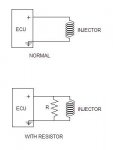Rukus said:
how do you put a resistor in parallel with one injector? (there is no way)
You can't put a resistor in parallel with the injector? There is no way? I beg to differ. All you have to do is put it across the two wires that go to the injector. It's exactly the same as wiring two subwoofers in parallel. And wiring two injectors in parallel would make both injectors fire at the same time which wouldn't do any good so I'm not sure why you used that example.
What if there's only one wire that goes to the injector? That means the injector is using the engine as a ground and all you have to do is put a resistor from the injector wire to ground.
Both ways the resistor is wired in parallel with the injector. Both ways the resistor is only affecting the injector it is connected to. Both ways the ECU sees the resistance it is expecting. And both ways the injector is still seeing 12 volts and is using its normal amount of current. The only thing that is different is that the resistor is now drawing the current that the original 3 ohm injector would have drawn minus what the new injector is drawing.
The whole point of putting resistors in the circuit is to keep the load on the ECU the same as if it had the right injectors in it. The original 3 ohm injector draws a lot more current from the ECU than the 15 ohm injector.
1/R = 1/R1 + 1/R2
1/3 = 1/15 + 1/X
Multiply both sides by 45
15 = 3 + 45/X
12 = 45/X
X = 3.75 ohms ( A correction from my earlier post)
If a 3.75 ohm resistor wired in parallel with the new 15 ohm injector, the resistance that the ECU sees is 3 ohms and the voltage the injector sees is 12 volts. Both are getting what they expect. The resistor probably doesn't get that hot either because the duty cycle on it is probably only 20% or less at full throttle.
I = E/R
I = 12v/3.75 ohms = 3.2 Amps
E x I = Power
12v x 3.2A = 38.4 watts
At a 20% duty cycle
38.4 x 0.2 = 7.68 watts.
8 watts will feel barely warm let alone start a fire.
The new injector, following the same equations, draws 1.92 watts.
The old injector draws 12/3 x 12 x 0.2 = 9.6 watts = 7.68 +1.92.
With the old injector or the new one with the resistor in parallel, the ECU is putting out 4 amps while the injector is on.
If you wanted to do it the other way where you wanted to use the 3 ohm injector in a system that needed to to see 15 ohms, putting a 12 ohm resistor in series with the injector wouldn't work. The ECU would see the right resistance but the resistor is now dropping 9.6 volts and the injector is only seeing 2.4 volts.
I never said it was a good idea. As a matter of fact I said to check with someone else. But it was flat out wrong to say that you can't put a resistor in parallel with an injector.
Class is over. There'll be a pop quiz tomorrow based on the homework. Permission slips for the field trip to the chocolate factory have to turned in no later than Tuesday or you'll be staying behind and licking envelopes for Principal Skinner.
Steve

